ADMINISTRATIVE REPORT
Date: February 2, 1999
Author/Local: Jim Hall / 7130RTS No. 427
CC File No. 5757
Meeting Date: March 23, 1999
TO: Standing Committee on Transportation and Traffic FROM: General Manager of Engineering Services SUBJECT: Neighbourhood Traffic Calming Plans - Priorities and Process RECOMMENDATION
THAT the attached discussion paper (Appendix "B") be presented to Resident Associations and the public for comment, and that staff report back on the results with recommendations on the methods for establishing priorities and the process for neighbourhood traffic calming plans.
GENERAL MANAGER'S COMMENTS
The General Manager of Engineering Services is concerned if we deviate too far from neighbourhood based traffic calming studies. By examining complete neighbourhoods, staff and residents can achieve a consensus on solutions which balance calming measures and traffic flows on all streets. (In fact, some of our past problems have arisen when we have addressed only individual street segments.)
Nonetheless, there may be some street segments where a quicker response can be achieved to a problem. This report suggests a process and safeguards against the diversion of traffic which is recommended for public discussion. The General Manager of Engineering Services supports the consultation process which will be reported to Council.
COUNCIL POLICY
The Vancouver Transportation Plan emphasizes the need to mitigate the effects of traffic in local neighbourhood areas and indicates that the City's traffic calming program will give priority to streets and neighbourhoods where traffic impacts are the most serious.
It is Council policy to implement diversionary traffic calming measures on a trial basis, with a follow-up survey, before making the measures permanent.PURPOSE
The purpose of this report is to improve the neighbourhood traffic calming process by seeking public comment on the attached discussion paper. The discussion paper identifies some of the issues in the development of traffic calming plans:
- setting the priorities for initiating traffic calming plans;
- the process for implementing a traffic calming plan; and
- defining the acceptable amount of increased traffic that could result on adjacent residential streets due to a traffic calming plan.The discussion paper would be mailed to Neighbourhood Resident Associations, members of resident committees that have recently been involved in traffic calming plans, and residents that request a copy. Public input would be sought through a Public Information meeting which will be advertised in local papers. Based on these comments, staff would report back to Council this spring to establish a policy regarding the method of establishing priorities and the process for neighbourhood traffic calming plans.
DISCUSSION
Traffic calming involves slowing the speed or reducing the volume of vehicular traffic on neighbourhood streets to increase safety and livability in the neighbourhood. Traffic calming could include measures such as traffic circles, corner bulges, partial diverters, diagonal diverters, signs prohibiting a vehicular movement, street closures, and street narrowing. A trial program is currently underway to evaluate speed humps.
In the past, neighbourhood traffic calming plans were initiated on either a first-come, first-served basis, or were generated from Council initiatives such as Local Area Plans. Due to increasing demand for traffic calming, there is currently a backlog of neighbourhoods waiting for these neighbourhood traffic calming plans. Appendix "A" provides a listing of plans currently being worked on, some of the areas which have requested traffic calming, and some of the requests for traffic calming due to complaints about speeding. A method of establishing priorities is required to ensure neighbourhoods are treated equitably and to ensure that limited staff and monetary resources are allocated where they are needed most. The 1997 Transportation Plan suggests that the priorities for traffic calming be based on objective criteria such as traffic speeds and volume. The attached paper discusses this approach.
There are two current processes for implementing traffic calming measures:
- a neighbourhood-wide traffic calming plan funded by the City; and
- the Local Improvement Program whereby property owners can petition to pay for the traffic calming device.The City has implemented a number of neighbourhood-wide traffic calming plans (eg. West End, Strathcona, and more recently Clinton Park and South Kerrisdale neighbourhoods). This process has been successful in that it examines the neighbourhood as a unit, thereby achieving a balance of calming measures and traffic flows. It is also highly interactive, building neighbourhood understanding and consensus. The biggest drawback to a neighbourhood based process is that it is time consuming with some plans requiring from two to three years to complete. For some neighbourhoods, the building of a consensus can be a difficult and slow process. This requires substantial staff resources, thereby delaying the response to other neighbourhoods.
The 1997 Transportation Plan suggests that the City expand its approach to traffic calming to include a process whereby an individual problem street or street segment is calmed using a solution which does not involve diversion of traffic to other streets (eg. installing a traffic circle). While it is recognized that a neighbourhood-wide process is appropriate for dealing with many of Vancouver's traffic problems (eg. non-local traffic short-cutting) and solutions (eg. diversionary measures such as street closures), for certain situations the calming of a street or street segment with non-diversionary measures can be accomplished in a more timely manner (eg. less than one year) than a traffic calming plan involving the whole neighbourhood. The attached discussion paper suggests that the street or street segment process for traffic calming could be used for certain situations rather than the Local Improvement Program or neighbourhood-wide process.
In addition to a new system for establishing the priorities for traffic calming plans and a new process (street or street segment), the attached paper discusses the concept of defining the acceptable amount of traffic to be diverted to adjoining residential streets due to a traffic calming plan. The City would take corrective action, if acceptable levels of diverted traffic are exceeded.
It is proposed to refer this discussion paper to the public for discussion, and to report the results back to Council with recommended policies.
* * * * *
APPENDIX "A"
TRAFFIC CALMING PLANS
A. WORK IN PROGRESS:
Arbutus Lands Neighbourhood Traffic Calming Plan
Blenheim Street (4th to 16th) Traffic Calming Plan
Clinton Park Neighbourhood Traffic Calming Plan
Cypress Street (4th to Cornwall) Traffic Calming
Plan
Dunbar-Marine Drive Triangle Neighbourhood Traffic
Calming Plan
Dunbar Street (south of SW Marine Drive) Traffic
Calming Plan
Heather Street (49th to Marine Drive) Traffic
Calming Plan
Kerrisdale South Neighbourhood Traffic Calming Plan
Marpole West Neighbourhood Traffic Calming Plan
Mount Pleasant Neighbourhood Traffic Calming Plan
Napier Street (east of Victoria Drive) Traffic
Calming Plan
Prince Edward Street (41st to 33rd) Traffic Calming
Plan
Semlin Street Traffic Calming Plan
Skeena Street (north of Hastings) Traffic Calming
Plan
Wall Street Neighbourhood Traffic Calming Plan
BIKEWAYS:
37th Avenue
Adanac
Burrardview
Lakewood North
Mosaic
Ontario
GREENWAYS:
Ridgeway West
OTHER PROJECTS:
Speed Hump Pilot Project
Trans Canada Trail
40 kph Speed Limit on Residential Streets
B. SOME OF THE ADDITIONAL REQUESTS FOR TRAFFIC
CALMING PLANS
(Depending on the results of field evaluations, these could be other neighbourhood traffic calming plans or a street segment calming plan)
Dunbar - City Plan Visioning Kensington / Cedar
Cottage - City Plan Visioning
Hastings/Pender/Turner Douglas Park - 16th / King
Edward, Oak / Cambie
41st / 49th, East Boulevard / Cypress Kerr. West -
41st / 49th, Blenheim / West Blvd.
16th / King Edward, Cambie / Main King Edward /
33rd, Cambie / Main
57th / Marine Drive, Cambie / Main E 59th / SE
Marine, Knight / Argyle
49th / 57th, Main / Fraser 16th / King Edward, Main
/ Fraser
Broadway / 12th, Fraser / Clark Drive Broadway,
Grandview / Nanaimo
Kingsway / King Edward, Fraser / Knight 4th /
Broadway, Alma / Macdonald
Mackenzie / 45th St. Catherines / 19th
Hastings / 1st, Commercial / Nanaimo 6th / Broadway,
Oak / Cambie
C. LIST OF SOME OF THE REQUESTS FOR TRAFFIC CALMING DUE TO COMPLAINTS ABOUT SPEEDING
The solution to these speeding concerns could
include:
- speed humps which are being tested in several
locations in the City (e.g. Carrington Street and Fremlin Street adjacent Oak Park); or
- a 40 kph speed limit on residential streets
(currently being reviewed by the Provincial Government).
| 1700 | ADANAC ST | 1700 | E KENT AV SOUTH | 500 | RAYMUR AV |
| 2000 | ADANAC ST | 1800 | E KENT AV SOUTH | 2900 | ROSEMONT DRIVE |
| 3000 | ADANAC ST | 2000 | E KENT AV SOUTH | 7500 | ROSS ST |
| 3200 | ADANAC ST | 2000 | E PENDER ST | 2000 | SASAMAT ST |
| 6500 | ADERA ST | 2200 | E PENDER ST | 1500 | SLOCAN ST |
| 5700 | ALMA ST | 5500 | EARLES ST | 2800 | SOPHIA ST |
| 6100 | ALMA ST | 6600 | EAST BOULEVARD | 2900 | SPRUCE ST |
| 7500 | ANGUS DRIVE | 2000 | FRANKLIN ST | 1800 | SPYGLASS PLACE |
| 1100 | ARBUTUS ST | 2000 | FRANKLIN ST | 4400 | ST. CATHERINES ST |
| 1400 | ARBUTUS ST | 3500 | FRANKLIN ST | 4200 | STAULO CRESCENT |
| 6800 | ARBUTUS ST | 3600 | FRANKLIN ST | 2200 | TOLMIE ST |
| 6200 | ARLINGTON ST | 3600 | FRANKLIN ST | 2200 | TRIMBLE ST |
| 6900 | ARLINGTON ST | 3800 | FRANKLIN ST | 4700 | VALLEY DRIVE |
| 2800 | ASH ST | 7700 | FREMLIN ST | 2300 | VANNESS AV |
| 6500 | BALACLAVA ST | 7700 | FREMLIN ST | 2900 | VANNESS AV |
| 3400 | BLAKE ST | 8400 | FREMLIN ST | 3300 | VANNESS AV |
| 6500 | BLENHEIM ST | 2300 | GLEN DRIVE | 3000 | VENABLES ST |
| 7100 | BLENHEIM ST | 3800 | GLEN DRIVE | 500 | VERNON DRIVE |
| 2700 | CAMBRIDGE ST | 1800 | GRANT ST | 1900 | W 01ST AV |
| 3300 | CAMOSUN ST | 1800 | GRANT ST | 1900 | W 01ST AV |
| 3300 | CAMOSUN ST | 2200 | GRANT ST | 1900 | W 01ST AV |
| 7000 | CARNARVON ST | 1400 | GRAVELEY ST | 2100 | W 01ST AV |
| 7100 | CARRINGTON ST | 4500 | HARRIET ST | 2700 | W 03RD AV |
| 7100 | CARRINGTON ST | 3400 | HEATHER ST | 2800 | W 03RD AV |
| 500 | CASSIAR ST | 3600 | HEATHER ST | 3000 | W 05TH AV |
| 3700 | CEDAR CRESCENT | 3600 | HEATHER ST | 1000 | W 07TH AV |
| 2500 | CHARLES ST | 7800 | HEATHER ST | 2200 | W 07TH AV |
| 900 | CHARLESON | 8600 | HEATHER ST | 1900 | W 08TH AV |
| 1300 | CHESTNUT ST | 2200 | HIGHBURY ST | 4500 | W 08TH AV |
| 4700 | CLARENDON ST | 3200 | HIGHBURY ST | 1100 | W 10TH AV |
| 5500 | COLLEGE ST | 5800 | HIGHBURY ST | 1600 | W 10TH AV |
| 2900 | COLLINGWOOD ST | 6000 | HIGHBURY ST | 2400 | W 10TH AV |
| 5900 | COLUMBIA ST | 5700 | HOLLAND ST | 3000 | W 11TH AV |
| 1500 | COTTON DRIVE | 5700 | HOLLAND ST | 3600 | W 12TH AV |
| 5700 | CROWN ST | 7800 | HUDSON ST | 1100 | W 14TH AV |
| 6000 | CROWN ST | 6100 | INVERNESS ST | 1400 | W 15TH AV |
| 3100 | DIEPPE DRIVE | 4200 | JOHN ST | 4600 | W 15TH AV |
| 3300 | DIEPPE DRIVE | 5500 | KILLARNEY ST | 3700 | W 17TH AV |
| 4900 | DUMFRIES ST | 2000 | KITCHENER ST | 700 | W 19TH AV |
| 6400 | DUNBAR ST | 800 | LAGOON DRIVE | 1900 | W 19TH AV |
| 6400 | DUNBAR ST | 2000 | LAGOON DRIVE | 3100 | W 19TH AV |
| 3600 | DUNDAS ST | 200 | LAKEWOOD DRIVE | 3500 | W 24TH AV |
| 1300 | E 02ND AV | 400 | LAKEWOOD DRIVE | 3400 | W 27TH AV |
| 2800 | E 02ND AV | 2100 | LAKEWOOD DRIVE | 3800 | W 27TH AV |
| 2300 | E 03RD AV | 5300 | LARCH ST | 4200 | W 29TH AV |
| 1700 | E 06TH AV | 3800 | LAUREL ST | 3400 | W 31ST AV |
| 2100 | E 06TH AV | 3900 | LAUREL ST | 3800 | W 31ST AV |
| 1300 | E 07TH AV | 8600 | LAUREL ST | 2100 | W 37TH AV |
| 1800 | E 07TH AV | 4500 | MAPLE CRESCENT | 2700 | W 37TH AV |
| 1800 | E 07TH AV | 1500 | MARPOLE AV | 2700 | W 37TH AV |
| 300 | E 08TH AV | 1600 | MARPOLE AV | 2700 | W 37TH AV |
| 1500 | E 13TH AV | 1100 | MATTHEWS AV | 2900 | W 37TH AV |
| 1500 | E 14TH AV | 6700 | MCKINNON ST | 2900 | W 37TH AV |
| 400 | E 15TH AV | 600 | MCLEAN DRIVE | 600 | W 39TH AV |
| 1500 | E 16TH AV | 1600 | MCLEAN DRIVE | 3200 | W 39TH AV |
| 700 | E 17TH AV | 1800 | MCLEAN DRIVE | 3200 | W 39TH AV |
| 0 | E 18TH AV | 5100 | NANAIMO ST | 3400 | W 39TH AV |
| 100 | E 18TH AV | 2000 | NAPIER ST | 3600 | W 39TH AV |
| 1400 | E 18TH AV | 3600 | NORMANDY DRIVE | 3600 | W 39TH AV |
| 1700 | E 22ND AV | 5700 | OLYMPIC ST | 3400 | W 43RD AV |
| 1300 | E 23RD AV | 3200 | ONTARIO ST | 1900 | W 45TH AV |
| 0 | E 24TH AV | 3300 | ONTARIO ST | 3800 | W 46TH AV |
| 200 | E 24TH AV | 3700 | ONTARIO ST | 3700 | W 51ST AV |
| 600 | E 24TH AV | 5800 | ONTARIO ST | 3300 | W 53RD AV |
| 2000 | E 27TH AV | 7000 | ONTARIO ST | 300 | W 59TH AV |
| 2300 | E 27TH AV | 2400 | OXFORD ST | 1500 | W 62ND AV |
| 0 | E 28TH AV | 3500 | OXFORD ST | 1500 | W 64TH AV |
| 2000 | E 28TH AV | 2200 | PANDORA ST | 1900 | W 75TH AV |
| 2000 | E 28TH AV | 3600 | PANDORA ST | 3800 | W KING EDWARD AV |
| 0 | E 29TH AV | 3000 | PARKER ST | 5100 | WALES ST |
| 2200 | E 30TH AV | 1500 | PENTICTON ST | 5700 | WALLACE ST |
| 400 | E 31ST AV | 4400 | PINE CRESCENT | 5700 | WALLACE ST |
| 500 | E 31ST AV | 4800 | PINE CRESCENT | 2000 | WATERLOO ST |
| 2100 | E 34TH AV | 2500 | PINE ST | 3500 | WELLINGTON AV |
| 2400 | E 34TH AV | 5900 | PRINCE ALBERT ST | 3600 | WELLINGTON AV |
| 200 | E 36TH AV | 4200 | PRINCE EDWARD ST | 1100 | WINDERMERE ST |
| 1100 | E 39TH AV | 3300 | PUGET DRIVE | 3000 | WINDSOR ST |
| 1300 | E 43RD AV | 4000 | PUGET DRIVE | 4700 | WINDSOR ST |
| 1100 | E 45TH AV | 4600 | PUGET DRIVE | 1000 | WOLFE AV |
| 0 | E 51ST AV | 6000 | QUEBEC ST | 2000 | WOODLAND DRIVE |
| 300 | E 59TH AV | 3500 | QUESNEL DRIVE | 1600 | YEW ST |
| 1000 | E 59TH AV | 3600 | QUESNEL DRIVE | 6700 | YEW ST |
| 3000 | E GEORGIA ST | 3900 | QUESNEL DRIVE | 2300 | YORK AV |
| 2200 | E KENT AV NORTH | 4100 | QUESNEL DRIVE | ||
| 1600 | E KENT AV SOUTH |

APPENDIX "B"
DISCUSSION PAPER
Calming Traffic on Residential Streets: Some New
Approaches
City of Vancouver February 1999
Vancouver City Council seeks input
This discussion paper is being distributed to the
public by the City of Vancouver. Public input is sought on
how the City establishes priorities for
neighbourhood traffic calming plans and the process for conducting
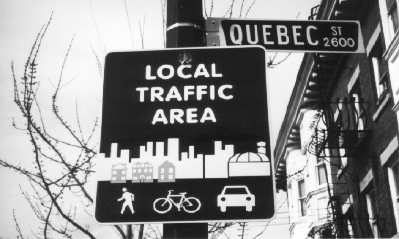
these plans. The public is asked to read this discussion paper, complete the survey at the back and return it in the pre-stamped envelope. Based on these comments, City staff will prepare a report back to Council with recommendations on the priorities and process for neighbourhood traffic calming plans.
Public Input
This discussion paper is being mailed to neighbourhood resident associations, members of resident committees that have recently been involved in traffic calming plans and residents that request a copy (contact Jim Hall at 873-7130 or [email protected]). Public input is also being sought through a public information meeting which will be advertised in local papers.
Background
The City has implemented a number of traffic calming plans, generally conducted on a neighbourhood-wide basis (eg. the West End, Strathcona, and more recently Clinton Park and South Kerrisdale neighbourhoods). Improvements in the current process for these neighbourhood traffic calming plans are required to address concerns with timeliness and equity. Currently, these plans can take from two to three years to complete, require substantial staff resources and can be quite divisive for the neighbourhood.
Due to increasing demand for traffic calming plans, there is currently a backlog of neighbourhoods waiting for traffic calming. A method of establishing priorities is required to ensure neighbourhoods are treated equitably and that limited staff and monetary resources are allocated where they are needed most.
The issues identified for discussion in this
pamphlet relate to:
- setting the priorities for initiating traffic
calming plans;
- the process for implementing a traffic calming
plan;
- defining the acceptable amount of increased
traffic that could result on adjacent residential streets due to a traffic calming plan;
and
- the survey areas and approval rates.
Your response and comments on the enclosed survey form are appreciated. Please complete the survey and return it in the pre-stamped envelope. Additional written comments may be enclosed.
If you have any questions or would be interested in joining a working group to review the details of the priority setting and processes as described in this discussion paper, please call Jim Hall at 873-7130 or e-mail [email protected].
WHAT IS TRAFFIC CALMING?
Traffic calming involves slowing the speed or reducing the volume of vehicular traffic on neighbourhood streets to increase safety and liveability in the neighbourhood. Traffic calming measures could include traffic circles, corner bulges, partial diverters, diagonal diverters, signs prohibiting a vehicular movement, street closures, and street narrowing. A trial program is currently underway to evaluate speed humps.
Traffic circle "calms" traffic.
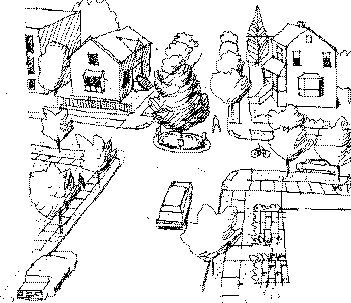
Examples of these calming measures can be found in
neighbourhoods which have already been traffic calmed such as the West End, Strathcona,
Mount Pleasant, Shaughnessy, Grandview-Woodlands, and Kitsilano. Speed humps are being
piloted in the Dunbar-41st-Marine Drive neighbourhood.
HOW ARE PRIORITIES ESTABLISHED FOR STARTING TRAFFIC CALMING PLANS?
![]() Individual
or group contacts by phone, e-mail, in person, or letter the Neighbourhood Transportation
Branch at City Hall to describe a traffic speed or volume concern on their neighbourhood
street.
Individual
or group contacts by phone, e-mail, in person, or letter the Neighbourhood Transportation
Branch at City Hall to describe a traffic speed or volume concern on their neighbourhood
street.
 City
staff evaluate the concern. This would involve reviewing existing traffic data such as
speeds, volumes and accidents, doing field checks, andacquiring more data which can
provide a measure of the "before" condition in the event that calming measures
are implemented.
City
staff evaluate the concern. This would involve reviewing existing traffic data such as
speeds, volumes and accidents, doing field checks, andacquiring more data which can
provide a measure of the "before" condition in the event that calming measures
are implemented.
Staff compare this traffic data to a set of guidelines which define an acceptable level of traffic on the various types of residential streets in Vancouver. Sidebar 1 provides information about these guidelines.
Sidebar 1. In Vancouver, it is suggested that
a neighbourhood "local" residential street is characterized by:
- fewer than three police reported accidents per
year or five accidents in two years;
- 85% of vehicles travel less than the speed
limit; and
- fewer than 1,000 vehicles per day in
single-family detached neighbourhood and 3,000 in a multi-family dwelling neighbourhood.
A higher level of traffic might be expected if the street is designated as a "collector" street or there are other trip generators within the neighbourhood, particularly nearby commercial areas.
In the past, neighbourhood traffic calming plans were initiated on either a first-come, first-served basis or were generated from City initiatives such as Local Area Plans. Due to increasing demand for these traffic calming plans, there is a current backlog of neighbourhoods waiting for a plan. Thus, priorities need to be established for traffic calming plans. To be equitable, priorities should be based on the criteria which objectively measure the problem. Problems identified by residents usually involve the speed and volume of the traffic on their street. Therefore, the proposed primary criteria for setting priorities are speed and volume.
The City of Vancouver Transportation Plan which
was approved in 1997 reported that the Seattle and Portland approaches to traffic calming
have been used successfully for a number of years. The City of Portland model for
establishing priorities involves assigning each street segment a numerical score. Points
are assigned on the basis of:
- speeds greater than 5 mph above the posted limit;
- volume of traffic per day;
 -
elementary schools on the project street
-
elementary schools on the project street
- pedestrian generators that result in a significant
number of pedestrians on the street (such as parks, community centers, and high schools);
- designated pedestrian routes;
- designated bicycle routes;
- designated transit routes; and
- pedestrian facilities with no continuous sidewalk
on at least one side of the street.
Traffic calming projects are selected from the street segments with the highest rankings.
The Portland model can be modified to suit Vancouver (eg. kilometres per hour instead of miles per hour, points if street adjacent to a Greenway or Bikeway).
DISCUSSION - Should priorities for traffic
calming plans be established on objective criteria such as speed and volume of traffic?
Should the Portland model, as modified for Vancouver
be used to establish these priorities?
Should priority be given to neighbourhoods going
through City-initiated Local Area Plans or new developments with substantial traffic
increases?
(See survey question #1 at back of paper).
WHAT IS THE PROCESS FOR IMPLEMENTING A TRAFFIC CALMING PLAN?
There are three possible processes for traffic
calming depending on the problem and potential solutions:
- the Local Improvement Program;
- a "neighbourhood-wide" traffic calming
plan; or
- a "street segment" traffic calming plan.
The Local Improvement Program is available for residents to pay for the cost of traffic calming measures when their street is not deemed to be a problem or they are very low on the priority list. A neighbourhood-wide plan is City-funded and is used when the problem is non-local, external traffic short-cutting through the neighbourhood or if the solution involves diversionary measures. A street segment calming plan is also City-funded and is appropriate if the problem is localized on a particular street segment and the solution involves non-diversionary measures.
All three process will be used in Vancouver
depending on the traffic problem and potential solutions. The following describes each of
these three processes and seeks input on ways to improve each process.
Local Improvement Program
"It's like an Indy raceway out here with the traffic volumes and speeds; but the City says my street is a low priority. So what can I do?"
If the measured traffic volumes or speeds result in a low priority compared with other requests throughout the City, the property owners can petition through the City's Local Improvement Program to pay for a traffic calming device such as a traffic circle or corner bulge. In this process, at least 2/3 of property owners must agree (by signing a petition) to pay for the traffic calming device at their cost.
DISCUSSION - Should property owners be
able to get traffic calming measures by paying for their cost or rather, should traffic
calming measures only be built where they are clearly warranted? (See survey question #2
at back of paper).
Neighbourhood-wide Traffic Calming Plan
"Okay, the City agrees I've got a traffic problem. How do we deal with this problem?"
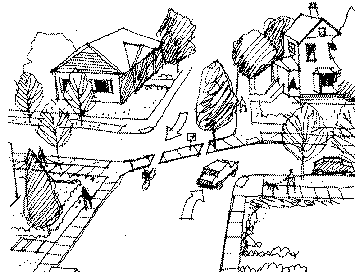 Where
the traffic volumes / speeds are a problem, the City may initiate a neighbourhood-wide
traffic calming plan at City cost. For example, if the problem is non-local, external
traffic short-cutting through the neighbourhood, then a neighbourhood-wide plan may be
appropriate. The problem on the one street likely cannot be addressed in isolation from
the other streets in the neighbourhood, as the problem is more widespread. Also, if
residents on the one problem street want to install diversionary measures such as a street
closure or diverter, then traffic would likely be diverted onto other streets. Again, a
neighbourhood-wide traffic calming plan would be appropriate, so that impacts could be
addressed in a coordinated way. This is a fairly long process as extensive neighbourhood
consultation / consensus is required.
Where
the traffic volumes / speeds are a problem, the City may initiate a neighbourhood-wide
traffic calming plan at City cost. For example, if the problem is non-local, external
traffic short-cutting through the neighbourhood, then a neighbourhood-wide plan may be
appropriate. The problem on the one street likely cannot be addressed in isolation from
the other streets in the neighbourhood, as the problem is more widespread. Also, if
residents on the one problem street want to install diversionary measures such as a street
closure or diverter, then traffic would likely be diverted onto other streets. Again, a
neighbourhood-wide traffic calming plan would be appropriate, so that impacts could be
addressed in a coordinated way. This is a fairly long process as extensive neighbourhood
consultation / consensus is required.
Figure 1 contains a checklist for a suggested process for a neighbourhood-wide traffic calming plan.
DISCUSSION - Is there general agreement
with this process? Does it provide suitable public involvement? How can neighbourhood
consensus be reached? Are there areas where this process can be improved? (See survey
question #2 at back of paper).
The City pays for neighbourhood-wide traffic calming
plans through Capital Plan funds approved by the electorate every three years during
municipal elections. Should the City / all taxpayers pay for plans or shouldresidents on
affected streets pay? (See survey question #3 at back of paper)
Figure 1. Checklist for the process for a neighbourhood-wide traffic calming plan
meet with residents in the neighbourhood to
discuss the nature of the problem and potential solutions. A residents' committee would be
struck to work with City staff.
the residents' committee and City staff design a
traffic plan.
sponsor an Open House to provide information on the
Plan.
survey the impacted residents for their opinion.
meet with residents' committee to discuss survey
results and revisions (if necessary) to the plan.
survey again the abutting residents for their
opinion of the changed plan (may be a sub-set of the neighbourhood which is most impacted
by the changes).
report to Council for approval and funding
authority.
inform the residents of Council action, next steps
and timetable.
implement a six month trial of the plan.
measure the traffic impacts of the calming measures
including the impacts on neighbouring streets to ensure traffic (above an acceptable
amount) has not been diverted.
survey again the impacted residents for their
opinion on the installed temporary calming measures.
report to Council on the trial (if the trial
includes diversionary measures).
inform the residents of the next steps and
timetable.
implement the plan on a permanent basis.
Street Segment Traffic Calming Plan
"I don't want a process that involves the whole neighbourhood. It takes too long. The problem is only on my street and we should be able to do something fairly easily without impacting my neighbours' streets."
A review of successful traffic calming processes in Seattle and Portland determined that rather than neighbourhood-wide traffic calming plans, these cities initiate traffic calming on particular streets or street segments. Streets are chosen on the basis of a point-ranking system using criteria such as traffic speeds, volumes and accidents (see prior section on establishing priorities).
Vancouver could also use this process when the traffic volumes or speeds on a particular street have been identified as a significant problem and the recommended solution is non-diversionary calming measures such as traffic circles or corner bulges. In this
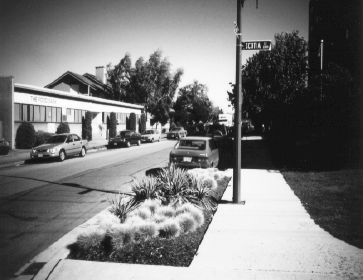 Landscaped corner bulge
Landscaped corner bulge
case, the process can proceed in a more timely manner than a neighbourhood-wide plan.
Only immediately impacted residents are consulted because traffic diversion to adjacent streets would not be expected. For example, for a traffic circle at an intersection, only the residents within one block of the intersection would be consulted. However, traffic counts would be done on adjacent streets to ensure there is no diverted traffic. If there is, calming measures could be initiated on those streets or the recently installed calming measure could be removed.
Figure 2 lists the process for traffic calming on a street or street segment at City cost.
DISCUSSION - Is there general agreement
with this process? Does it provide suitable public involvement? Are there areas where this
process can be improved? (See survey question #2 at back of paper).
As with neighbourhood-wide traffic calming plans,
the City pays for street segment traffic calming plans. Should the City / all taxpayers
pay for plans or should residents on affected streets pay? (See survey question #3 at back
of paper)
Figure 2. Checklist for the process for a traffic calming plan on a street or street segment
meet with residents from the street to discuss the nature of the problem and potential solutions. A residents' committee would be struck to work with City staff.
residents' committee and City staff meet to design a preliminary traffic calming plan.
survey residents for their opinion on the preliminary traffic calming plan (either a vote or a request for comments back).
report to Council for approval and funding authority.
inform the residents of Council action, next steps and timetable.
permanently implement the traffic calming measures.
after six months, measure the traffic impacts of
the calming measures including the impacts on neighbouring streets to ensure traffic
(above an acceptable amount) has not been diverted.
adjust calming measures if justified based on
traffic impacts.
WILL TRAFFIC BE DIVERTED ONTO MY STREET?
Many residents are concerned that a proposed traffic calming measure on their neighbour's street may result in traffic increases on their own street. Therefore, they may be reluctant to support the measures on their neighbour's street and may request calming measures on their own street even though the measures may not be warranted. These concerns are valid and an approach should be developed to address these concerns.
The City could define an acceptable level of traffic diversion onto neighbouring streets, monitor actual diversion levels, and take corrective action if the acceptable levels are exceeded.
In Portland, the acceptable amount of increased traffic on adjacent residential streets due to a traffic calming plan is defined as an increase of 150-400 vehicles per day depending on the prior traffic volume. A street with very low prior traffic volumes could accept an increase of 150 vehicles per day while a street with 2,000 or more vehicles per day could accept an increase of 400 vehicles per day.
DISCUSSION - Should a guiding principle of
a Traffic Calming Plan be that the traffic on a street be calmed without diverting any
traffic to adjoining neighbourhood streets?
Or, similar to Portland, should an acceptable amount
of increased traffic on adjacent streets due to a traffic calming plan be allowed (say, a
percentage increase or an absolute increase of 150-400 vehicles per day), with the City
monitoring and taking corrective measures if the allowable limit is exceeded?
(See survey question #4 at back of paper).
SURVEY AREAS AND APPROVAL RATE
Once a preliminary traffic calming plan has been developed, there should be a neighbourhood survey to find out how people feel about the proposal. There are two factors involved with the neighbourhood survey: the area surveyed and the approval rate.
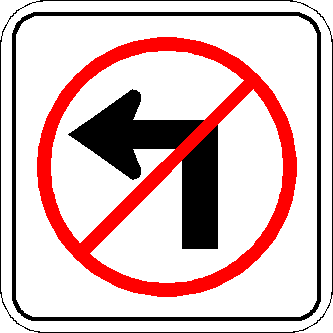 The
area to be surveyed should depend on whether the traffic calming measures being proposed
are of a diversionary nature such as signs prohibiting a turning movement, diverters or
street closures. If other, adjoining streets in a neighbourhood are likely to be impacted,
then the residents on those streets should be given the opportunity to vote on the traffic
calming plan.
The
area to be surveyed should depend on whether the traffic calming measures being proposed
are of a diversionary nature such as signs prohibiting a turning movement, diverters or
street closures. If other, adjoining streets in a neighbourhood are likely to be impacted,
then the residents on those streets should be given the opportunity to vote on the traffic
calming plan.
An issue concerning survey approval rates is how many people are needed to approve a change. An approval response that is borderline, such as 51% of those responding, indicates the neighbourhood is very divided on the traffic calming plan.
DISCUSSION - Should the survey area for
installing a non-diversionary traffic calming measure be defined as being one block from
the intersection in which the proposed device is to be located?
Should the survey area for installing diversionary
traffic calming measures be defined as the area which will be significantly impacted from
the proposed installation of this calming measure?
(See survey question #5 at back of paper)
Should the approval rate for the traffic calming
plan be 50% of those responding or a higher percentage such as 60%?
(See survey question #6 at back of paper)
 |
**********************************************************************
|
**********************************************************************
| CITY OF VANCOUVER - SURVEY RESPONSE FORM
| PRIORITIES AND PROCESS FOR NEIGHBOURHOOD
TRAFFIC | CALMING PLANS
|
| Please return this survey in the stamped
self-addressed envelope, or fax it to 871-6192. All responses will remain
confidential. If you have any questions, call Jim Hall at 873-7130 or e-mail [email protected]
![]() ***************************
***************************
|
Name:____________________________________________________ Phone #: _______________
|
| Address:
________________________________________________________________________________________
|
| Resident Association Name:
______________________________________________________________________
|
| ***************************
| 1.Establishing priorities for traffic calming
plans based on objective criteria such as traffic speed and volume is
| acceptable. Agree Disagree No comment
| I offer the following comments on the method for
establishing priorities:
|
|
________________________________________________________________________________________________
|
|
________________________________________________________________________________________________
|
|
________________________________________________________________________________________________
|
| 2.Depending on the traffic problems and potential
solutions, there are three methods available for initiating traffic
| calming plans (Local Improvement Program,
Neighbourhood-wide Traffic Calming Plan or Street Segment Traffic
| Calming Plan). As described in the Discussion
Paper,
| the Local Improvement program is good. Agree
Disagree No comment
| It would be useful in my neighbourhood. Agree
Disagree No comment
|
| I offer the following comments on the Local
Improvement Program:
|
|
________________________________________________________________________________________________
|
|
________________________________________________________________________________________________
|
| As described in the Discussion Paper, the
Neighbourhood Agree Disagree No comment
| -wide process is good
It would be useful in my neighbourhood. Agree
Disagree No comment
I offer the following comments on the process for
Neighbourhood-wide Traffic Calming Plans:
![]() |
|
|
____________________________________________________________________________________________
|
|
________________________________________________________________________________________________
As described in the Discusssion paper, the Street Agree Disagree No comment
segment process is good.
It would be useful in my neighbourhood. Agree Disagree No comment
I offer the following comments on the process for Street Segment Traffic Calming Plans:
_____________________________________________________________________________________________
________________________________________________________________________________________________
________________________________________________________________________________________________
3.The City / all taxpayers pay for neighbourhood-wide and street segment traffic calming plans. Should this continue or should residents on affected streets pay?
________________________________________________________________________________________________
________________________________________________________________________________________________
4.A limited amount of traffic diversion onto adjacent streets is acceptable in order to address traffic problems in the neighbourhood overall, with the condition that the City will monitor and take corrective measures if the allowable limit is exceeded. This is acceptable for Vancouver. Agree Disagree No comment
I offer the following comments about accepting a limited amount of traffic diversion onto adjacent streets:
____________________________________________________________________________________________
________________________________________________________________________________________________
5.The survey areas are dependent on the potential for diverting traffic onto adjacent residential streets. The survey areas as described are acceptable. Agree Disagree No comment
I offer the following comments on the survey areas:
________________________________________________________________________________________________
________________________________________________________________________________________________
6.The survey approval rate of those responding should be: 50% 60% No comment
I offer the following comments on the survey approval rate:
________________________________________________________________________________________________
________________________________________________________________________________________________
7. Please provide further comments on a separate sheet of paper.
CITY OF VANCOUVER SURVEY RESPONSE FORM - February 1999
Comments or questions? You can send us email.
(c) 1998 City of Vancouver